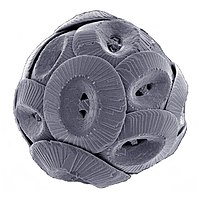
Photo from wikipedia
The most well recognized magnetoreception behavior is that of the magnetotactic bacteria (MTB), which synthesize membrane-bounded magnetic nanocrystals called magnetosomes via a biologically controlled process. The magnetic minerals identified in… Click to show full abstract
The most well recognized magnetoreception behavior is that of the magnetotactic bacteria (MTB), which synthesize membrane-bounded magnetic nanocrystals called magnetosomes via a biologically controlled process. The magnetic minerals identified in prokaryotic magnetosomes are magnetite (Fe3 O4 ) and greigite (Fe3 S4 ). Magnetosome crystals, regardless of composition, have consistent, species-specific morphologies and single-domain size range. Because of these features, magnetosome magnetite crystals possess specific properties in comparison to abiotic, chemically-synthesized magnetite. Despite numerous discoveries regarding MTB phylogeny over the last decades, this diversity is still considered underestimated. Characterization of magnetotactic microorganisms is important as it might provide insights into the origin and establishment of magnetoreception in general, including eukaryotes. Here we describe the magnetotactic behavior and characterize the magnetosomes from a flagellated protist using culture-independent methods. Results strongly suggest that, unlike previously described magnetotactic protists, this flagellate is capable of biomineralizing its own anisotropic magnetite magnetosomes which are aligned in complex aggregations of multiple chains within the cell. This organism has a similar response to magnetic field inversions as MTB. Therefore, this eukaryotic species might represent an early origin of magnetoreception based on magnetite biomineralization. It should add to the definition of parameters and criteria to classify biogenic magnetite in the fossil record. This article is protected by copyright. All rights reserved.
Journal Title: Environmental microbiology
Year Published: 2019
Link to full text (if available)
Share on Social Media: Sign Up to like & get
recommendations!